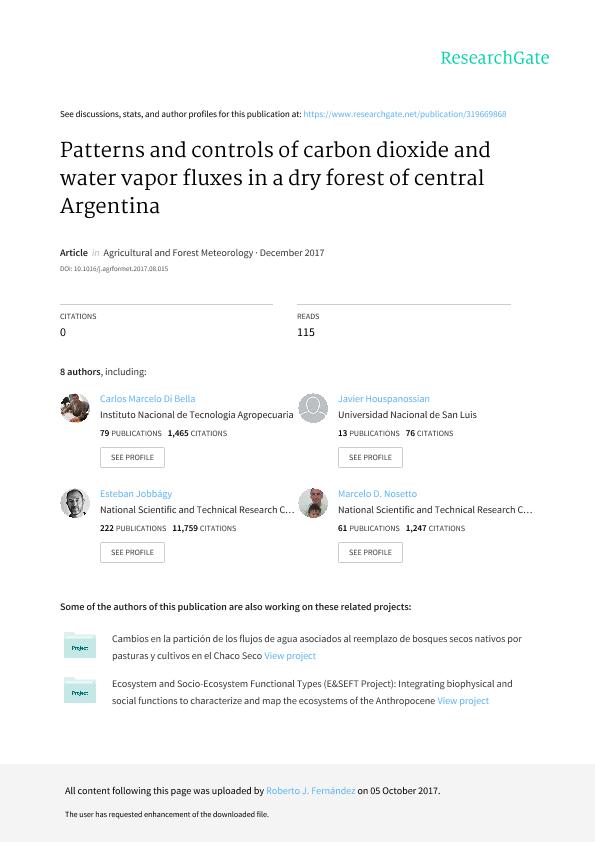Mostrar el registro sencillo del ítem
dc.contributor.author
García, Alfredo Gabriel

dc.contributor.author
Di Bella, Carlos Marcelo

dc.contributor.author
Houspanossian, Javier

dc.contributor.author
Magliano, Patricio Nicolás

dc.contributor.author
Jobbagy Gampel, Esteban Gabriel

dc.contributor.author
Posse Beaulieu, Gabriela

dc.contributor.author
Fernandez Alduncin, Roberto Javier

dc.contributor.author
Nosetto, Marcelo Daniel

dc.date.available
2018-11-28T15:17:44Z
dc.date.issued
2017-12
dc.identifier.citation
García, Alfredo Gabriel; Di Bella, Carlos Marcelo; Houspanossian, Javier; Magliano, Patricio Nicolás; Jobbagy Gampel, Esteban Gabriel; et al.; Patterns and controls of carbon dioxide and water vapor fluxes in a dry forest of central Argentina; Elsevier Science; Agricultural And Forest Meteorology; 247; 12-2017; 520-532
dc.identifier.issn
0168-1923
dc.identifier.uri
http://hdl.handle.net/11336/65424
dc.description.abstract
Covering 16% of global land surface, dry forests play a key role in the global carbon budget. The Southern Hemisphere still preserves a high proportion of its native dry forest cover, but deforestation rates have increased dramatically in the last decades. In this paper, we quantified for the first time the magnitude and temporal variability of carbon dioxide and water vapor fluxes and their environmental controls based on eddy covariance measurements in a dry forest site of central Argentina. Continuous measurements of CO2 and water vapor exchanges spanning a 15-month period (Dec. 2009 – March 2011) showed that the studied dry forest was a net sink of carbon, with an overall integrated net ecosystem exchange (NEE) of −172 g C m−2 (−132.8 g C m−2 for year 2010). The cool dry season (May–Sept.) accounted for a quarter of the total annual NEE of year 2010 with low but steady CO2 uptake rates (1 g C m−2 d−1 on average) that were more strongly associated with temperature than with soil moisture. By contrast, in the warm wet season (Oct.–April), almost three times greater CO2 uptake rates (2.7 g C m−2 d−1 on average) resulted from a highly pulsed behavior in which CO2 uptake showed sharp increases followed by rapid declines after rainfall events. Cumulative evapotranspiration (ET) during the whole study (595 mm) accounted for most of the rainfall inputs (674 mm), with daily water vapor fluxes during the wet season being four times greater compared to those observed during the dry season (1.7 mm d−1 vs. 0.45 mm d−1). Modeling of the partition of all evaporative water losses suggested that transpiration was the dominant vapor flux (67% of ET), followed by interception (20%) and soil evaporation (13%). The influence of air temperature on half-hourly CO2 fluxes was notably different for the dry and wet seasons. In the 11–34 °C air temperature range, CO2 uptake rates were higher in the warm wet rather than the cool dry season, yet this difference narrowed with temperatures >26 °C. The dry forest became a net CO2 source at 40 °C. Our study provides new insights about the functioning of dry forests and the likely response of their CO2 and water vapor exchange with the atmosphere under future climate and land use/cover changes.
dc.format
application/pdf
dc.language.iso
eng
dc.publisher
Elsevier Science

dc.rights
info:eu-repo/semantics/openAccess
dc.rights.uri
https://creativecommons.org/licenses/by-nc-sa/2.5/ar/
dc.subject
Carbon Balance
dc.subject
Chaco
dc.subject
Deforestation
dc.subject
Eddy Covariance
dc.subject
Net Ecosystem Exchange
dc.subject.classification
Ciencias Medioambientales

dc.subject.classification
Ciencias de la Tierra y relacionadas con el Medio Ambiente

dc.subject.classification
CIENCIAS NATURALES Y EXACTAS

dc.subject.classification
Oceanografía, Hidrología, Recursos Hídricos

dc.subject.classification
Ciencias de la Tierra y relacionadas con el Medio Ambiente

dc.subject.classification
CIENCIAS NATURALES Y EXACTAS

dc.title
Patterns and controls of carbon dioxide and water vapor fluxes in a dry forest of central Argentina
dc.type
info:eu-repo/semantics/article
dc.type
info:ar-repo/semantics/artículo
dc.type
info:eu-repo/semantics/publishedVersion
dc.date.updated
2018-10-23T17:40:55Z
dc.journal.volume
247
dc.journal.pagination
520-532
dc.journal.pais
Países Bajos

dc.journal.ciudad
Amsterdam
dc.description.fil
Fil: García, Alfredo Gabriel. Consejo Nacional de Investigaciones Científicas y Técnicas; Argentina. Instituto Nacional de Tecnología Agropecuaria. Centro de Investigación de Recursos Naturales. Instituto de Clima y Agua; Argentina
dc.description.fil
Fil: Di Bella, Carlos Marcelo. Consejo Nacional de Investigaciones Científicas y Técnicas; Argentina. Instituto Nacional de Tecnología Agropecuaria. Centro de Investigación de Recursos Naturales. Instituto de Clima y Agua; Argentina. Universidad de Buenos Aires. Facultad de Agronomía. Departamento de Métodos Cuantitativos y Sistemas de Información; Argentina
dc.description.fil
Fil: Houspanossian, Javier. Consejo Nacional de Investigaciones Científicas y Técnicas. Centro Científico Tecnológico Conicet - San Luis. Instituto de Matemática Aplicada de San Luis "Prof. Ezio Marchi". Universidad Nacional de San Luis. Facultad de Ciencias Físico, Matemáticas y Naturales. Instituto de Matemática Aplicada de San Luis "Prof. Ezio Marchi"; Argentina
dc.description.fil
Fil: Magliano, Patricio Nicolás. Consejo Nacional de Investigaciones Científicas y Técnicas. Centro Científico Tecnológico Conicet - San Luis. Instituto de Matemática Aplicada de San Luis "Prof. Ezio Marchi". Universidad Nacional de San Luis. Facultad de Ciencias Físico, Matemáticas y Naturales. Instituto de Matemática Aplicada de San Luis "Prof. Ezio Marchi"; Argentina
dc.description.fil
Fil: Jobbagy Gampel, Esteban Gabriel. Consejo Nacional de Investigaciones Científicas y Técnicas. Centro Científico Tecnológico Conicet - San Luis. Instituto de Matemática Aplicada de San Luis "Prof. Ezio Marchi". Universidad Nacional de San Luis. Facultad de Ciencias Físico, Matemáticas y Naturales. Instituto de Matemática Aplicada de San Luis "Prof. Ezio Marchi"; Argentina
dc.description.fil
Fil: Posse Beaulieu, Gabriela. Instituto Nacional de Tecnología Agropecuaria. Centro de Investigación de Recursos Naturales. Instituto de Clima y Agua; Argentina
dc.description.fil
Fil: Fernandez Alduncin, Roberto Javier. Consejo Nacional de Investigaciones Científicas y Técnicas. Oficina de Coordinación Administrativa Parque Centenario. Instituto de Investigaciones Fisiológicas y Ecológicas Vinculadas a la Agricultura. Universidad de Buenos Aires. Facultad de Agronomía; Argentina
dc.description.fil
Fil: Nosetto, Marcelo Daniel. Consejo Nacional de Investigaciones Científicas y Técnicas. Centro Científico Tecnológico Conicet - San Luis. Instituto de Matemática Aplicada de San Luis "Prof. Ezio Marchi". Universidad Nacional de San Luis. Facultad de Ciencias Físico, Matemáticas y Naturales. Instituto de Matemática Aplicada de San Luis "Prof. Ezio Marchi"; Argentina. Universidad Nacional de Entre Ríos. Facultad de Ciencias Agropecuarias; Argentina
dc.journal.title
Agricultural And Forest Meteorology

dc.relation.alternativeid
info:eu-repo/semantics/altIdentifier/doi/https://dx.doi.org/10.1016/j.agrformet.2017.08.015
dc.relation.alternativeid
info:eu-repo/semantics/altIdentifier/url/https://www.sciencedirect.com/science/article/pii/S0168192317302721
Archivos asociados
